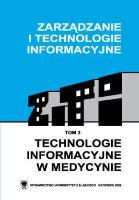Telerehabilitacja – aplikacje praktyczne w ortopedii i traumatologii narządu ruchu
Telerehabilitation – Practical Applications in Orthopaedics and Traumatology of the Locomotor System
Author(s): Wojciech Glinkowski, Andrzej Górecki, Konrad Mąkosa, Monika WasilewskaSubject(s): Economy
Published by: Wydawnictwo Uniwersytetu Śląskiego
Keywords: telerehabilitation; orthopaedics and traumatology of the locomotor system; the version 1.0 of the Telerehabilitation System; videoconferencing system
Summary/Abstract: The development of telemedicine expands into domains previously not explored. One of the new areas of telemedicine is telerehabilitation, which allows providing rehabilitation services remotely over telecommunications networks or the Internet. Clinical assessment, remotely supervised therapy and teleeducation are widely implemented in telerehabilitation. We have conducted preliminary research utilizing dedicated applications we developed. The capabilities of musculoskeletaltelerehabilitation, telementoring, and remotely supervised kinesiotherapy were tested extensively. Telerehabilitation seems to become a way of providing therapy for patients who are not able to reach a rehabilitation outpatient facility. The videoconferencing systems are most commonly used for providing two-way patient-therapist video communication. Videoconferencing systems may utilize Internet, stationary phone-based, ISDN, satellite or even 3G mobile services. The preliminary research in the Center of Excellence “TeleOrto” for Telediagnostics and Therapy of Disorders and Injuries of Locomotor System employed an Internet telerehabilitation application as well 3G telerehabilitation. The version 1.0 of the Telerehabilitation System is based on one remote server, to which an entitled person is able to connect from anywhere on the Earth. Teleeducation in rehabilitation can be provided successfully using the described Internet videoconferencing system. The interoperability and relatively low expenses are the most attractive features of that system. In musculoskeletal telerehabilitation the employment of teleECG monitoring as well as utilizing other sensors allows transmitting signals from a patient to the supervising physician, who increases the safety of therapy and rises up patient’s trust.
Journal: Zarządzanie i Technologie Informacyjne
- Issue Year: 2008
- Issue No: 3
- Page Range: 225-241
- Page Count: 17
- Language: Polish

